How the ratings surfaced
Humana’s update followed the unintentional public release of preliminary 2026 star-rating data by CMS. After the regulator briefly posted detailed plan information on its website, Humana elected to publish its own summary to satisfy securities-disclosure rules. For context, CMS assigns ratings from one to five stars on the basis of clinical quality, member experience, and administrative performance. More information on the methodology can be found on the Centers for Medicare & Medicaid Services website.
Financial impact and strategic response
In a statement, the Louisville-based carrier acknowledged dissatisfaction with the new results but pointed to “tactical operational improvements” completed late in the 2026 measurement period. Executives said those steps—closing gaps in preventive care, intensifying member outreach, and expanding data analytics—should pave the way for a return to top-quartile performance in the 2027 ratings cycle.
Humana has also taken legal action against the federal government, arguing that recent methodological changes unfairly penalized certain plans. Concurrently, management has ramped up investments in technology to track quality metrics and deployed additional clinical staff to high-risk members.
Market reaction
Despite the mixed picture, Humana’s share price rose approximately 3 % after the filing became public. Analysts noted that the jump in 4.5-star enrollment mitigates some concern about the broader decline and signals progress in targeted contracts.
Broader industry context
Star ratings have become a central competitive lever in the $400 billion MA market. Insurers with higher scores not only receive richer federal payments but also leverage those funds to offer lower premiums or enhanced benefits. After the 2024 ratings cycle, several large carriers saw similar declines when CMS tightened certain measures, particularly those tied to patient-experience surveys. Humana’s outsized exposure stems from its status as the nation’s second-largest MA operator, with roughly five million members.
Next steps
Looking ahead, Humana said it will focus on:
- Expanding in-home clinical assessments to identify care gaps sooner.
- Automating outreach programs to boost medication adherence scores.
- Strengthening partnerships with providers to improve chronic-disease management.
Management reiterated guidance that 2026 will be a “transition year” and expressed confidence in regaining four-star density above 75 % for 2027. The company will provide further detail during its next quarterly earnings call.
For additional coverage of the financial implications for health-care companies, visit our Finance News Update section.
Image credit: Humana Inc.



